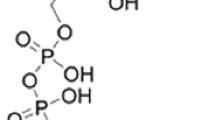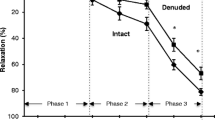Summary
Cultured coronary endothelial cells and the coronary endothelium of isolated perfused guinea-pig hearts are characterized by a very active adenosine and adenine nucleotide metabolism. Adenosine applied to the endothelium at low concentrations is avidly metabolized and preferentially incorporated into different nucleotide pools—only a minor amount is degraded to uric acid. Physiologically, the coronary endothelium therefore functions as an impermeable metabolic barrier for interstitially or intravascularly accumulating adenosine. Only at concentrations≧10−6M adenosine can pass the endothelial barrier. As a consequence, the vasodilatory action of adenosine formed in or administered into the coronary system cannot be induced by a direct association of the nucleoside with the putative adenosine receptor of the arteriolar smooth muscle cells, but must be mediated by the endothelium. High molecular weight derivatives of adenosine, clearly confined to the coronary system, can also induce a coronary dilation. The endothelium-mediated smooth muscle relaxation is therefore obviously due to triggering of an extracellular adenosine receptor at the luminal surface of the endothelium. Since this process is accompanied by a rapid and pronounced activation of the adenylate cyclase system, the endothelial receptor conforms to an A2-type.
According to our results it is necessary to reconsider qualitative and quantitative facets of the adenosine hypothesis of metabolic regulation of coronary blood flow, which—in its original formulation —exclusively centers on the cardiomyocyte metabolism. With respect to the vasoactivity of adenosine one obviously has to distinguish between its action from the interstitial space directly via the myocyte receptors of the vessel wall, and/or its action from the intracoronary space via the newly detected endothelial A2-receptor. More information is needed to determine the extent to which both receptor populations actually participate in the metabolic regulation of coronary flow under physiological and pathophysiological conditions.
Similar content being viewed by others
References
Afonso S, Ansfield TJ, Berndt TB, Rowe GG (1972) Coronary vasodilator responses to hypoxia before and after aminophylline. J Physiol 221:589–599
Anversa P, Levicky V, Beghi C, McDonald SL, Kikkana Y (1983) Morphometry of exercise-induced right ventricular hypertrophy in the rat. Circ Res 52:57–64
Bassingthwaighte JB, Yipintsoi T, Harvey RB (1974) Microvasculature of the dog left ventricular myocardium. Microvasc Res 7:229–249
Belloni FL (1979) The local control of coronary blood flow. Cardiovasc Res 13:63–85
Bennett AS, Luft JH, Hampton JC (1959) Morphological classification of vertebrate blood capillaries. Am J Physiol 196:381–390
Berne RM (1963) Cardiac nucleotides in hypoxia: possible role in regulation of coronary blood flow. Am J Physiol 204:317–322
Berne RM, Rubio R (1979) Coronary circulation. In: Berne RM, Sperelakis N (eds) Handbook of Physiology. The Cardiovascular System. Section 2, vol 1, chap 25, Am Physiol Soc, Washington DC, pp 873–952
Böck M, Nees S, Möller A, Gerlach E (1985) Extrazellulärer Abbau von Adeninnukleotiden (AN) an Endothelzellen (EC) aus verschiedenen Gefäßabschnitten und im Vollblut. Z Kardiol 74:Suppl 3
Bünger R, Haddy FJ, Querengässer A, gerlach E (1974) An isolated guinea pig heart preparation with in vivo like features. Pflügers Arch 353:317–326
Bünger R, Haddy FJ, Gerlach E (1975) Coronary responses to dilating substances and competitive inhibition by theophylline in the isolated perfused guinea pig heart. Pflügers Arch 358:213–224
Cryer A (1983) Biochemical interactions at the endotthelim. Elsevier, Amsterdam, New York, Oxford
Daly JW (1982) Adenosine receptors: targets for future drugs. J Med Chem 25:197–207
Daly JW (1985) Adenosine receptors. In: Cooper DMF, Simon KB (eds) Advances in cyclic nucleotides and protein phosphorylation research. Raven Press, New York, Vol 19, pp 29–46
Degenring FH, Curnish RR, Rubio R, Berne RM (1976) Effect of dipyridamole on myocardial adenosine metabolism and coronary flow in hypoxia and reactive hyperemia in the isolated perfused guinea pig heart. J Mol Cell Cardiol 8:877–888
Eikens E, Wilcken DEL (1973) The role of endothelium in the response of vascular smooth muscle to drugs. Ann Rev Pharmacol Toxicol 24:175–197
Furchgott RF (1984) The role of endothelium in the response of vascular smooth muscle to drugs. Ann Rev Pharmacol Toxicol 24:175–197
Feigl EO (1983) Coronary Physiology. Physiol Rev 63:1-205 Am Physiol Soc
Fishman A (1982) Endothelium. Annals of the New York Academy of Sciences, Vol 401. The New York Academy of Science, New York
Gerlach E, Deuticke B, Dreisbach RH (1963) Der Nucleotid-Abbau im Herzmuskel bei Sauerstoffmangel und seine mögliche Bedeutung für die Coronardurchblutung. Naturwissenschaften 50:228–229
Giles RW, Wilcken DEL (1977) Reactive hyperemia in the dog heart: inter-relations between adenosine, ATP, and aminophylline and the effect of indomethacin. Cardiovasc Res 11:113–121
Gudbjarnason S, Mathes P, Ravens KG (1970) Functional compartmentation of ATP and creatine phosphate in the heart muscle. J Mol Cell Cardiol 1:325–339
Jaffe EA (1984) Biology of endothelial cells. Martinus Nijhoff Publishers, Boston, The Hague, Dordrecht, Lancaster
Jarasch ED, Grund C, Bruder G, Heid HW, Keenan TW, Franke WW (1981) Localization of xanthine oxidase in mammary gland epithelium and capillary endothelium. Cell 25:67–82
Jones CE, Hurst TW, Randall JR (1982) Effect of aminophylline on coronary functional hyperemia and myocardial adenosine. Am J Physiol 243:H480–487
Klocke FJ, Ellis AK (1980) Control of coronary blood flow. Ann Rev Med 31:489–508
Kübler W, Spieckermann PG, Bretschneider HJ (1970) Influence of dipyridamole (Persantin) on myocardial adenosine metabolism. J Mol Cell Cardiol 1:23–38
Langendorff O (1985) Untersuchungen am überlebenden Säugetierherzen. Pflügers Arch 61:291–332
Liu MS, Feinberg H (1971) Incorporation of adenosine 8-14C and inosine 8-14C into rabbit heart adenine nucleotides. Am J Physiol 220:1242–1248
Meisel M, Meisel P (1974) Is adenosine the mediator for the regulation of the coronary circulation and for the effciency of coronardilators? Pharmazie 29:561–568
Nees S, Gerbes AL, Gerlach E (1981) Isolation, identification, and continuous culture of coronary endothelial cells from guinea pig hearts. Eur J Cell Biol 24:287–297
Nees S, Böck M, Gerlach E (1983) Tissue culture of endothelial cells: New technologic approaches. In: Crone C (ed) Nouvelles methodes d'étude de la microcirculation. Institut national de la santé et de la recherche médicale. Paris Faculté X. Bichat, pp 19–34
Nees S, Böck M, Herzog V, Becker B, Des Rosiers C, Gerlach E (1985) The adenine nucleotide metabolism of the coronary endothelium: implications for the regulation of coronary flow by adenosine. In: Schubert P, Stefanovich V, Rudolphi K (eds) Adenosine: receptors and modulation of cell function. IRL Press, Oxford, England (in press)
Olsson RA, Patterson RE (1976) Adenosine as a physiological regulator of coronary blood flow. In: Hahn FE (ed) Progress in Molecular and Subcellular Biology, Springer-Verlag, New York, pp 227–248
Olsson RA, Davis CJ, Khouri EM, Patterson RE (1976) Evidence for an adenosine receptor on the surface of dog coronary myocytes. Circ Res 39:93–98
Paolini HJ, Wilcken DEL (1971) Inter-relation between the actions of dipyridamole, adenosine, aminophylline and propranolol on the coronary circulation of the transplanted dog heart. Anst J Exp Biol Med Sci 49:537–552
Parrat JR, Wadsworth RM (1972) The effects of dipyridamole on the myocardial vasodilator actions of noradrenaline, isoprenaline and adenosine. Br J Pharmacol 46:585–593
Rhodin JAG (1967) The ultrastructure of mammalian arterioles and precapillary sphincters. J Ultrastruct Res 18:181–223
Salpeter MM, Bachmann L (1964) Autoradiography with the electron microscope. A procedure for improving resolution, sensitivity, and contrast. J Cell Biol 22:469–477
Sasaki R, Watanabe Y, Morishita T, Yamagata S (1968) Estimation of the cell number of heart muscles in normal rats. Tohoku J Exp Med 95:177–184
Scholtholt J, Nitz RE, Schraven E (1972) On the mechanism of antagonistic action of xanthine derivatives against adenosine and coronary vasodilators. Arzneim Forsch 22:1225–1259
Schrader J (1976) Compartmentation of cardiac adenine nucleotides and formation of adenosine. Pflügers Arch 367:129–135
Schrader J (1977) Release of adenosine, inosine, and hypoxanthine from the isolated guinea pig heart during hypoxia, flow-autoregulation and reactive hyperemia. Pflügers Arch 369:1–6
Schrader J, Nees S, Gerlach E (1977) Evidence for a cell surface adenosine receptor on coronary myocytes and atrial muscle cells. Pflügers Arch 369:251–257
Schrader J (1981) Sites of action and production of adenosine in the heart. Receptors Recognition Series B 12:121–162
Shepro D, D'Amore PA (1984) Physiology and biochemistry of the vascular wall endothelium. In: Renkin EM, Michel C Ch, Geiger SR (eds) Handbook of Physiology. The Cardiovascular System, Section 2, Vol IV, Microcirculation, Part. 1. American Physiological Socitety, Bethesda, Maryland, pp 103–164
Simionescu M, Simionescu N (1978) Isolation and characterization of endothelial cells from the heart microvasculature. Microvasc Res 16:426–452
Stone TN (1983) Purine receptor classification: a point for discussion. TIPS 5:492
Wiedmeier VTh, Rubio R, Berne RM (1972) Incorporation and turnover of adenosine-U-14C in perfused guinea pig myocardium. Am J Physiol 223:51–54
Zydowo M (1976) Adenine compounds and the heart. Int J Biochem 7:353–357
Author information
Authors and Affiliations
Additional information
Part of the results have been presented to the “Deutsche Gesellschaft für Herz- und Kreislaufforschung” on the occasion of the 51st meeting held in Mannheim, April 12–14, 1985.
Rights and permissions
About this article
Cite this article
Nees, S., Herzog, V., Becker, B.F. et al. The coronary endothelium: a highly active metabolic barrier for adenosine. Basic Res Cardiol 80, 515–529 (1985). https://doi.org/10.1007/BF01907915
Received:
Issue Date:
DOI: https://doi.org/10.1007/BF01907915




